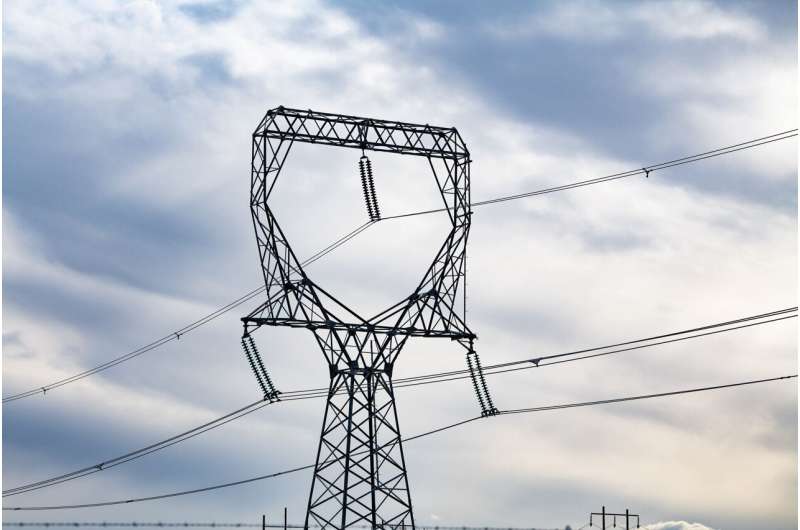New all-liquid iron flow battery for grid energy storage
A commonplace chemical used in water treatment facilities has been repurposed for large-scale energy storage in a new battery design by researchers at the Department of Energy’s Pacific Northwest National Laboratory. The design provides a pathway to a safe, economical, water-based, flow battery made with Earth-abundant materials. It provides another pathway in the quest to incorporate intermittent energy sources such as wind and solar energy into the nation’s electric grid.
The researchers report in Nature Communications that their lab-scale, iron-based battery exhibited remarkable cycling stability over one thousand consecutive charging cycles, while maintaining 98.7% of its maximum capacity. For comparison, previous studies of similar iron-based batteries reported degradation of the charge capacity two orders of magnitude higher, over fewer charging cycles.
Iron-based flow batteries designed for large-scale energy storage have been around since the 1980s, and some are now commercially available. What makes this battery different is that it stores energy in a unique liquid chemical formula that combines charged iron with a neutral-pH phosphate-based liquid electrolyte, or energy carrier. Crucially, the chemical, called nitrogenous triphosphonate, nitrilotri-methylphosphonic acid or NTMPA, is commercially available in industrial quantities because it is typically used to inhibit corrosion in water treatment plants.
Phosphonates, including NTMPA, are a broad chemical family based on the element phosphorus. Many phosphonates dissolve well in water and are nontoxic chemicals used in fertilizers and detergents, among other uses.

“We were looking for an electrolyte that could bind and store charged iron in a liquid complex at room temperature and mild operating conditions with neutral pH,” said senior author Guosheng Li, a senior scientist at PNNL who leads materials development for rechargeable energy storage devices. “We are motivated to develop battery materials that are Earth-abundant and can be sourced domestically.”
What is a flow battery?
As their name suggests, flow batteries consist of two chambers, each filled with a different liquid. The batteries charge through an electrochemical reaction and store energy in chemical bonds. When connected to an external circuit, they release that energy, which can power electrical devices. Unlike other conventional batteries, flow batteries feature two external supply tanks of liquid constantly circulating through them to supply the electrolyte, serving as the battery system’s “blood supply.” The larger the electrolyte supply tank, the more energy the flow battery can store.
Flow batteries can serve as backup generators for the electric grid. Flow batteries are one of the key pillars of a decarbonization strategy to store energy from renewable energy resources. Their advantage is that they can be built at any scale, from the lab-bench scale, as in the PNNL study, to the size of a city block.
In the near term, grid operators are looking to locate battery energy storage systems (BESS) in urban or suburban areas near energy consumers. Often, city planners must grapple with consumer safety concerns. The type of aqueous flow battery reported here could help alleviate safety concerns.
“A BESS facility using the chemistry similar to what we have developed here would have the advantage of operating in water at neutral pH,” said Aaron Hollas, a study author and team leader in PNNL’s Battery Materials and Systems Group. “In addition, our system uses commercially available reagents that haven’t been previously investigated for use in flow batteries.”
The research team reported that their initial design can reach energy density, a key design feature, up to 9 watt-hours per liter (Wh/L). In comparison, commercialized vanadium-based systems are more than twice as energy dense, at 25 Wh/L. Higher energy density batteries can store more energy in a smaller square footage, but a system built with Earth-abundant materials could be scaled to provide the same energy output.
Future development of aqueous redox flow batteries
“Our next step is to improve battery performance by focusing on aspects such as voltage output and electrolyte concentration, which will help to increase the energy density,” said Li. “Our voltage output is lower than the typical vanadium flow battery output. We are working on ways to improve that.”
PNNL researchers plan to scale-up this and other new battery technologies at a new facility called the Grid Storage Launchpad (GSL) opening at PNNL in 2024. The GSL will help accelerate the development of future flow battery technology and strategies so that new energy storage systems can be deployed safely.
More information:
Phosphonate-based Iron Complex for a Cost-Effective and Long Cycling Aqueous Iron Redox Flow Battery, Nature Communications (2024). DOI: 10.1038/s41467-024-45862-3
Pacific Northwest National Laboratory
Citation:
New all-liquid iron flow battery for grid energy storage (2024, March 25)
retrieved 25 March 2024
from https://techxplore.com/news/2024-03-liquid-iron-battery-grid-energy.html
This document is subject to copyright. Apart from any fair dealing for the purpose of private study or research, no
part may be reproduced without the written permission. The content is provided for information purposes only.

Comments are closed